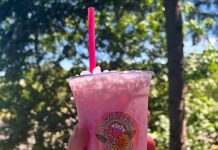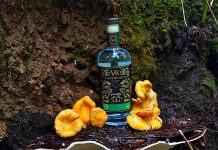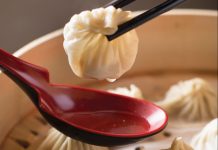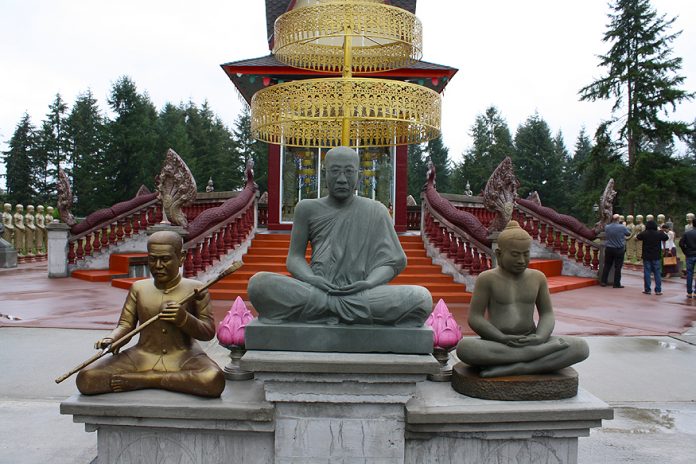
Cold rain drizzles outside but inside is an explosion of color, light, sound and scent. Hundreds of people, all decked out in their finest clothing, crowd into the small gathering space at Wat Prachum Raingsey in Yelm. Everyone is laughing, talking and greeting friends and family, each bearing food and other offerings for the ceremony.
 Today marks the culmination of the 15 day ceremony of Pchum Ben. Between 300 and 500 attendees from as far away as Canada and Oregon are expected to attend. According to Wat Prachum Raingsey temple member, Tara Svay, “This time of year we offer food to the souls of our ancestors and others. We bring the food here so the monk can bless it. He has the power to send the food to them.” This process began before sunrise as food was scattered across the ground as an offering to all the unknown souls.
Today marks the culmination of the 15 day ceremony of Pchum Ben. Between 300 and 500 attendees from as far away as Canada and Oregon are expected to attend. According to Wat Prachum Raingsey temple member, Tara Svay, “This time of year we offer food to the souls of our ancestors and others. We bring the food here so the monk can bless it. He has the power to send the food to them.” This process began before sunrise as food was scattered across the ground as an offering to all the unknown souls.
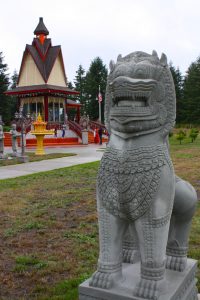
After passing through the open gathering area, attendees respectfully remove their shoes and enter the blessing room. Here they place their offering on the table before Wat Prachum Raingsey’s sole monk, dressed in his iconic maroon and orange robes. Then they find a seat on the floor’s lush maroon carpet while the monk carries out the blessing. He chants solemnly in Sanskrit while shaking a small bundle of wooden sticks soaked in holy water over the offerings.
Incense hangs heavy in the air. On one side of the room sits a large shrine featuring an ornate statue of the Buddha surrounded by colorful, blinking lights and piles of fresh flowers. Brightly colored wall hangings circle the room, depicting important events in the Buddha’s life culminating in his enlightenment. Svay points out one depicting the Buddha’s birth. “As soon as he was born he walked seven steps,” Svay says. “A lotus sprouted with each one. Then he became like a normal baby. An angel said that this would be his last incarnation. This one here shows the Buddha trying to achieve enlightenment through constant meditation and starving himself in the process. An angel came and played the guitar to him. First one string was too loose and it sounded bad. So the angel tightened it, but then it was too tight and it broke. This taught Buddha not to be so extreme. We need to live in between. Over there you can see where Buddha achieved enlightenment.”
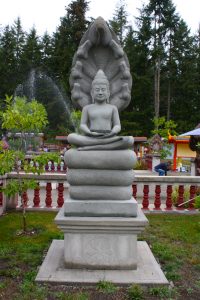
This is said to have occurred sometime in the 6th century B.C. Now, some 2600 years later, Buddhists strive to emulate his path. Wat Prachum Raingsey provides a place to focus on spirituality, observe religious holidays, perform sacred ceremonies and gather with friends and family. Its grounds are an exquisite oasis. A large fountain sits at the center flanked by dozens of artistically crafted statues, each deeply rooted in Cambodian Buddhist symbolism. “The dragons show power,” Svay says. “They intimidate evil from the perimeter of the temple. So does the giants and the lions. Then we have inspirational figures like Chun Nat who was the only person to translate the Cambodian dictionary, Krom Ngoy who was a genius in poetry and Chey Varaman, an important Cambodian king.” These statues have been shipped here piece by piece over the years all the way from Cambodia.
Most important of all is the large outdoor stupa. “People come here and do meditation, pray and sometimes ask for forgiveness,” Svay says. We watch several adherents remove their shoes before respectfully approaching the structure which houses a large statue of the Buddha flanked by his two most dedicated disciples. The stupa has eight sides representing the eight directions and Buddhism’s Eight Fold Path. Beneath sits a holding place for the ashes of those who wished to be placed here. The uppermost spire of the stupa will soon be home to a sacred relic. “We have received a relic of the Buddha from India which will be placed at the very top of the stupa,” Svay says. “Many nations fight for one so we’re very lucky to get it. It’s small, only the size of a grain. That’s it and it’s a blessing.”
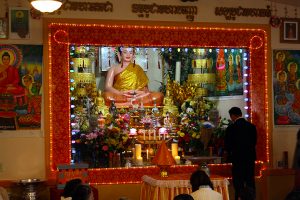
The layout of Wat Prachum Raingsey was designed by Board President Chheth Chuon to be balanced and uniform. It was built over the course of many years by hardworking members with generously donated funds. “This land was a farm with an old barn when we started,” Chuon says. “It looks good now. I can’t believe how it has turned out. If you believe in something, it will happen.” The temple is not done yet, with more statues yet to come and the stupa to finish. Chuon hopes to someday build a large gathering structure here, as the temple’s popularity is rapidly outgrowing its size.
Wat Prachum Raingsey is an essential part of the Cambodian Buddhists’ culture, spirituality and way of life. It is also essential in imparting wisdom to the next generation. “We bring kids here to observe,” Svay says. “Hopefully when they grow up they will recognize the culture and want to carry it on. It can be difficult. There are a lot of conflicts like sports and after school activities. Parents encourage them to come, but do not force.”
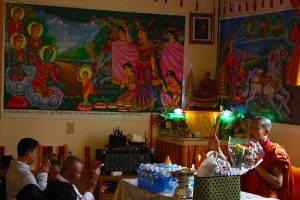
Back inside, the monk has begun chanting. It is rhythmic and monotone yet beautifully melodic. Some participants reach out, placing their hands on each other’s backs. Others press their hands flatly together and bow their heads reverently. According to Svay, “This is to humble yourself to receive the blessing with great respect. They are asking for forgiveness, cleaning out their souls.”
Just outside, local members scurry to organize and set out the massive amount of food that has gathered throughout the morning. It sits piled on two 40-foot long tables and soon overwhelms a third. The ceremony comes to a close as the monk begins to eat, something he must accomplish before noon, as monks of this tradition fast daily after this hour. Once he has begun eating, and the spirits have received their offering, everyone else helps themselves and the party truly begins.
Wat Prachum Raingsey is located at 14334 Yelm Hwy SE, in Yelm, Washington. It is open to the public seven days a week. For more information visit the Wat Prachum Raingsey Facebook page.





